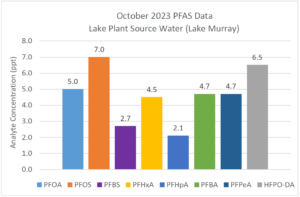Columbia Water continues to proactively sample for per- and polyfluoroalkyl substances (PFAS) in its drinking water every six months. Sampling efforts utilizing the same parameters as DHEC sampling, which occurred back in June of 2020, allow for analysis of the same 29 compounds.
Our October 05, 2023 PFAS sample results for source and finished water at both plants show about the same compounds that we have seen previously, and the two different analytical methods used show comparable results.
Source and Finished Drinking Water Sample Results
In this latest sampling round, we detected nine compounds in the Canal Plant source water, and eight of those in the finished water. We detected eight compounds in the Lake Plant source water, and only seven in the finished water. We detected the same compounds leaving each plant. Hexafluoropropylene oxide- dimer acid (HFPO-DA) – known as GenX was detected at the Lake Plant and, for the first time, at Canal Plant. October samples showed results at the two water treatment plants consistent with previous years, with a few compounds showing a decrease (PFHxA and PFPeA for Canal) or removal (PFHxS at Canal and PFHpA at the Lake).
Canal Water Treatment Plant Results


Lake Murray Water Treatment Plant Results


In order to monitor PFAS levels going forward, Columbia Water will continue to conduct its own source and finished water PFAS testing twice a year. Additionally, as part of the Unregulated Contaminant Monitoring Rule 5 (UCMR 5), we will begin sampling for 29 PFAS in December 2024.
You can find out more here: https://www.wileyjournalebooks.com/Opflow/2022/December/#p=14
Proposed PFAS Regulation
Up until last June, 2022 PFAS compounds had a non-enforceable, non-regulatory health advisory level associated with them. This level decreased significantly from 70 ppt back in 2016.

Fast forward to March 2023, the USEPA proposed maximum contaminant levels (MCLs) for two individual PFAS compounds and a group health index level for four other PFAS compounds seen on the table below. The table contains maximum contaminant level goals (MCLGs) and proposed enforceable levels or MCLs.

Columbia Water is currently exploring treatment options that would remove PFAS from drinking water and will perform bench-studies to evaluate the best technology to meet upcoming and impending regulatory levels.
For More Information: Please visit the EPA’s PFAS web page at www.epa.gov/pfas for tools, resources, and EPA actions to address PFAS. SCDHEC also has a resource page at www.scdhec.gov/BOW/perfluoroalkyl-substances-pfas, which includes results from all the drinking water systems they sampled. If you have additional questions, please contact our Drinking Water Compliance office at (803) 733-8211.






